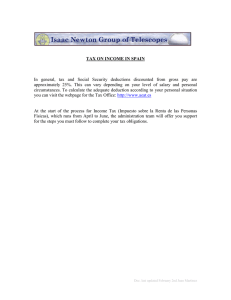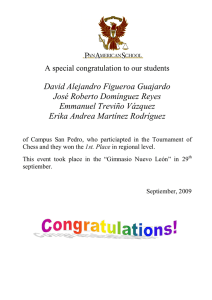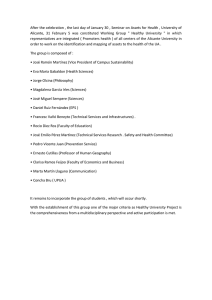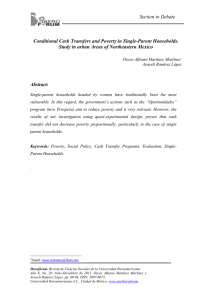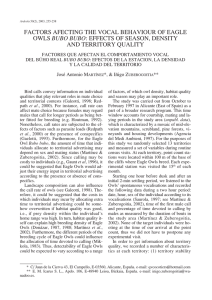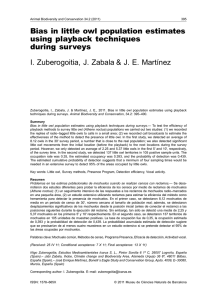article
Anuncio
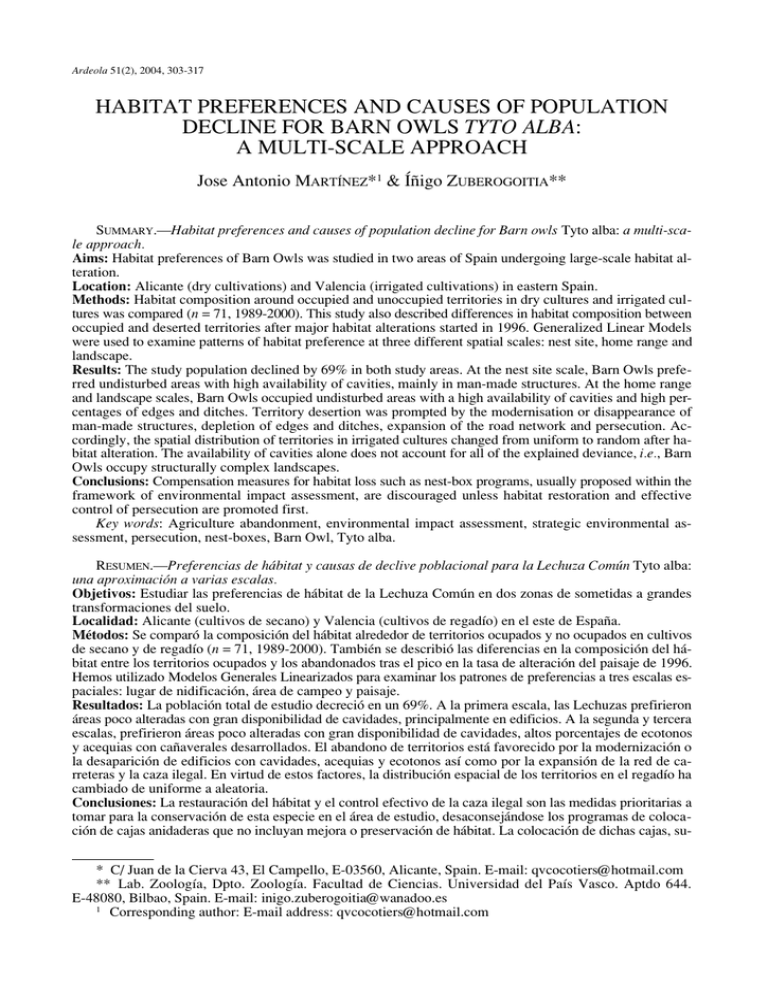
Ardeola 51(2), 2004, 303-317 HABITAT PREFERENCES AND CAUSES OF POPULATION DECLINE FOR BARN OWLS TYTO ALBA: A MULTI-SCALE APPROACH Jose Antonio MARTÍNEZ*1 & Íñigo ZUBEROGOITIA** SUMMARY.—Habitat preferences and causes of population decline for Barn owls Tyto alba: a multi-scale approach. Aims: Habitat preferences of Barn Owls was studied in two areas of Spain undergoing large-scale habitat alteration. Location: Alicante (dry cultivations) and Valencia (irrigated cultivations) in eastern Spain. Methods: Habitat composition around occupied and unoccupied territories in dry cultures and irrigated cultures was compared (n = 71, 1989-2000). This study also described differences in habitat composition between occupied and deserted territories after major habitat alterations started in 1996. Generalized Linear Models were used to examine patterns of habitat preference at three different spatial scales: nest site, home range and landscape. Results: The study population declined by 69% in both study areas. At the nest site scale, Barn Owls preferred undisturbed areas with high availability of cavities, mainly in man-made structures. At the home range and landscape scales, Barn Owls occupied undisturbed areas with a high availability of cavities and high percentages of edges and ditches. Territory desertion was prompted by the modernisation or disappearance of man-made structures, depletion of edges and ditches, expansion of the road network and persecution. Accordingly, the spatial distribution of territories in irrigated cultures changed from uniform to random after habitat alteration. The availability of cavities alone does not account for all of the explained deviance, i.e., Barn Owls occupy structurally complex landscapes. Conclusions: Compensation measures for habitat loss such as nest-box programs, usually proposed within the framework of environmental impact assessment, are discouraged unless habitat restoration and effective control of persecution are promoted first. Key words: Agriculture abandonment, environmental impact assessment, strategic environmental assessment, persecution, nest-boxes, Barn Owl, Tyto alba. RESUMEN.—Preferencias de hábitat y causas de declive poblacional para la Lechuza Común Tyto alba: una aproximación a varias escalas. Objetivos: Estudiar las preferencias de hábitat de la Lechuza Común en dos zonas de sometidas a grandes transformaciones del suelo. Localidad: Alicante (cultivos de secano) y Valencia (cultivos de regadío) en el este de España. Métodos: Se comparó la composición del hábitat alrededor de territorios ocupados y no ocupados en cultivos de secano y de regadío (n = 71, 1989-2000). También se describió las diferencias en la composición del hábitat entre los territorios ocupados y los abandonados tras el pico en la tasa de alteración del paisaje de 1996. Hemos utilizado Modelos Generales Linearizados para examinar los patrones de preferencias a tres escalas espaciales: lugar de nidificación, área de campeo y paisaje. Resultados: La población total de estudio decreció en un 69%. A la primera escala, las Lechuzas prefirieron áreas poco alteradas con gran disponibilidad de cavidades, principalmente en edificios. A la segunda y tercera escalas, prefirieron áreas poco alteradas con gran disponibilidad de cavidades, altos porcentajes de ecotonos y acequias con cañaverales desarrollados. El abandono de territorios está favorecido por la modernización o la desaparición de edificios con cavidades, acequias y ecotonos así como por la expansión de la red de carreteras y la caza ilegal. En virtud de estos factores, la distribución espacial de los territorios en el regadío ha cambiado de uniforme a aleatoria. Conclusiones: La restauración del hábitat y el control efectivo de la caza ilegal son las medidas prioritarias a tomar para la conservación de esta especie en el área de estudio, desaconsejándose los programas de colocación de cajas anidaderas que no incluyan mejora o preservación de hábitat. La colocación de dichas cajas, su* C/ Juan de la Cierva 43, El Campello, E-03560, Alicante, Spain. E-mail: qvcocotiers@hotmail.com ** Lab. Zoología, Dpto. Zoología. Facultad de Ciencias. Universidad del País Vasco. Aptdo 644. E-48080, Bilbao, Spain. E-mail: inigo.zuberogoitia@wanadoo.es 1 Corresponding author: E-mail address: qvcocotiers@hotmail.com 304 MARTÍNEZ, J. A. & ZUBEROGOITIA, Í. gerida tanto en los estudios de impacto ambiental como dentro de evaluaciones estratégicas ambientales de planes de desarrollo en la zona de estudio, se considera una medida compensatoria errónea, pues los modelos muestran que las Lechuzas Comunes ocupan paisajes estructuralmente más complejos que los determinados por la simple disponibilidad de cavidades para anidar. Palabras clave: Abandono de la agricultura, estudios de impacto ambiental, evaluaciones estratégicas ambientales, caza ilegal, cajas anidaderas, Lechuza Común, Tyto alba. INTRODUCTION The landscape in the Mediterranean basin has been subjected to a relentless process of alteration for centuries (Pain & Pienkowski, 1997). The rate of habitat alteration has steeply increased over the last fifty years so that little remains of the original or agricultural landscape, especially in coastal areas (Agencia del Medio Ambiente, 1997). In particular, the rate of habitat loss to large housing developments and extended road networks in the east coast of Spain peaked in 1996 (Simarro, 2002). Habitat loss occurred mostly at the expense of dry and irrigated cultures, which are otherwise being replaced by large fruit/vegetable greenhouses favoured by the reform of the Common Agricultural Policy (CAP) (Pain & Pienkowski, 1997). Contrary to other areas across Europe (Penteriani et al., 2002), abandonment of agricultural lands has not lead to a substantial expansion of the surface of forest mainly because of the rapid changes on the suitability for building of the abandoned lands and subsequent urbanisation (Simarro, 2002). Interestingly, human-maintained semi-natural systems have the potential to host a higher richness and diversity of species than extensive cultures or large forests as long as traditional agricultural practices are put into practice (Rico 1997; Sánchez-Zapata & Calvo, 1999; Zuberogoitia, 2000, Zuberogoitia, 2002). Indeed, the bulk of the raptor and owl population in Alicante (east of Spain) inhabits the agro-pastoral complex (Rico et al., 2001; Martínez et al., 2003). Paradoxically, birds of prey are protected but the conservation status of their preferred nesting and foraging habitats is low because they are located out of the network of Natural Parks. Therefore, the question is raised as to how the shrinking availability of the agro-pastoral complex would affect the probability of having occupied territories of listed species. An approach combining long temporal data series with multi-scale descriptions of the habitat preferences of the target species can produArdeola 51(2), 2004, 303-317 ce meaningful results with regard to the response of animals to habitat loss (Penteriani et al., 2001; Marchesi et al., 2002; Martínez et al., 2003). The multi-scale approach to the study of habitat preferences is mostly based on the conceptual framework proposed by Johnson (1980), whose basic assumption is that animals are capable of making decisions regarding resources at consecutively smaller scales. Accordingly, general habitat selection can be considered as a hierarchical process regarding, for example, a suitable patch for breeding at a small scale and apt areas for foraging at a broader scale (Martínez et al., 2003). The multiscale approach may be especially appropriate to identify key factors involved in habitat preference of owls because they have large home ranges consisting of different patches for breeding and foraging (Mikkola, 1983). The Barn Owl Tyto alba is one of the archetypal inhabitants of the agri-pastoral mosaics of Spain (Zuberogoitia, 2002). In common with other countries across Europe, a negative trend in population size has been reported in Spain, the ultimate causes of which are still poorly documented (Tucker & Heath, 1994; Martínez & Zuberogoitia, 2003a). However, several studies have pointed out the owl’s sensitivity to small-scale habitat changes (Taylor, 1994; Ramsden, 1998; Zuberogoitia, 2002), which suggests the importance of monitoring how changes in the traditional land uses affect the abundance of Barn Owls. Furthermore, recently released fauna catalogues such as the Decreto 32/2004 DOGV, 27 February (Comunidad Valenciana, East of Spain) do not list the Barn Owl as protected, an assessment based on the subjective criteria of the board because no large-scale survey has ever been performed in the area. On these grounds, we aim to: (1) catalogue relevant environmental characteristics affecting habitat preferences of Barn Owls at three different spatial scales (nest areas, home ranges and landscape) and (2) asses how habitat loss may be influencing the sustainability of a Barn Owl population. 305 HABITAT LOSS AND BARN OWL POPULATION DECLINE MATERIAL AND METHODS Study area The study was carried out between 1989 and 2000 in two study areas: (1) dry cultures, in the province of Alicante, and (2) irrigated cultures, in the province of Valencia (Fig. 1). In dry cultures the climate varies from semi-arid meso-mediterranean to sub-humid Mediterranean. Average annual rainfall is about 400 mm, and annual average temperature is about 19°C. The landscapes is dominated by dry cultivated fields, mainly Carob Ceratonia siliqua, Almond Prunus amygdalus, Olive trees Olea europaea, vineyards, barley, sunflowers, wheat, scrubland and pine forests (Pinus halepensis and Pinus pinea) and medium-sized cities. Altitude varies between 0 and 1500 m a.s.l. In the irrigated cultures area, the main land uses are citrus groves interspersed with vegetable smallholdings. Average annual rainfall is about 500 mm, and annual average temperature is about 18°C. Altitude varies between 0 and 300 m a.s.l. See Martínez (1998) and Martínez & López (1999) for further details. Survey methods In order to locate Barn Owls, nests, moulted feathers, droppings and food remains were loo- ked for in man-made structures, ephemeral rivers and trees (Shawyer, 1987; Taylor, 1994; Ramsden, 1998; Martínez & López, 1999; Zuberogoitia & Campos, 1998; Toms et al., 2001). As a complementary method, recordings of the male’s main territorial call were broadcast (Zuberogoitia & Campos, 1998). All territories (and random sites, see below) were visited four times each year to ascertain their occupancy according to the presence or absence of nests, pellets, droppings, moulted feathers, sightings or responses to playback (Taylor, 1994). Selection of scales Following the rationale of Johnson (1980), Martínez et al. (2003) and Martínez & Zuberogoitia (2004), three different spatial scales were used to study habitat preferences of Barn Owls: a) Nest site scale. Core areas during the breeding season can be encircled by a circle 1 km radius from the nests (Taylor, 1994) including nests, diurnal or nocturnal roosts and hunting grounds (Taylor, 1994). Hence, an average core area was assumed to be a circular 317 ha plot around the nests (1 km radius) (Taylor, 1994). b) Home range scale. Barn Owl home ranges vary in length from 2 to 5 km (Taylor, 1994). From these studies, an average territory was Unexplained bosque] FIG. 1.—Percentage of deviance explained at three spatial scales by the Generalized Linear Models for the probability of presence of Barn Owls comparing occupied vs. non occupied territories in dry areas. [Porcentajes de devianza explicados a tres escalas espaciales por los Modelos Generales Linearizados para la probabilidad de presencia de Lechuzas Comunes comparando territorios ocupados y no ocupados en áreas de cultivos de secano.] Ardeola 51(2), 2004, 303-317 306 MARTÍNEZ, J. A. & ZUBEROGOITIA, Í. assumed to be a circular area of 2826 ha around centres of activity (3 km radius). c) Landscape scale. Since landscape ecology addresses the relationships between animal distribution and mosaics of ecosystems (Forman & Gordon, 1986) tests were made for a possible response of Barn Owls to habitat composition at a broad landscape level. Thus, an area of 100 km2 around nests (5.6 km radius) was chosen because in Alicante and Valencia it is likely to find substantial changes in landscape composition within this radius (Agencia del Medi Ambient, 1997). Furthermore, other studies have reported responses of birds of prey and owls to this landscape scale in the study areas (Rico et al., 2001; Martínez et al., 2003; Martínez & Zuberogoitia, 2004). Selection of variables From 1:2000 aerial photographs and 1:2000 maps, an a priori set of environmental variables related to topography were selected (Burn- ham & Anderson, 2002) (1), human disturbance (3), land use (6), edges (3), linear structures (1) and nesting or roosting requirements (1) (see Appendix 1). Two studies have singled out illegal hunting as one of the most important proximate causes of mortality of raptors and owls in the study areas (Martínez et al., 1996; Martínez et al., 2001). From these studies and from unpublished data maps were developed which depicted the location of every raptor or owl casualty attributed to persecution. Then, the variable «persecution» was constructed as the presence (1) or absence (0) of records of persecution in the three circular sampling areas around centres of activity. The aim of the study was to test if territory abandonment is more likely to occur in areas where persecution takes place. During the course of routine visits the number and location of potential roosting or breeding sites was plotted on aerial photographs or detailed maps. Centres of activity are defined as nests or as the most frequently used roost judging from the amount of signs of activity (Ramsden, APPENDIX 1 Variables used to characterize centres of activity at the nest, home range and landscape scales. [Variables utilizadas para caracterizar el centro de actividad a escala del nido, territorio y paisaje.] Physiography RELIEF, number of 100 m contours cut by four lines starting from the centre of the area in directions N, S, E and W. Human disturbance PAVED ROADS, metres around the centre of activity. HOUSING DEVELOPMENTS, % PERSECUTION, presence (1) or absence (0) of records of persecution in the circular sampling area. Land use (%) CAROB, OLIVE, ALMOND CULTURES (TREE CULTURES) CEREAL CULTIVATIONS CITRUS GROVES VEGETABLE SMALLHOLDINGS EPHEMERAL RIVERS FOREST Edges (m) CERAL-FOREST CITRUS GROVES-SET ASIDE CULTIVATIONS CITRUS GROVES-VEGETABLE SMALLHOLDINGS Linear structures (m) DITCHES Nesting/roosting requirements NUMBER OF BUILDINGS WITH CAVITIES Ardeola 51(2), 2004, 303-317 HABITAT LOSS AND BARN OWL POPULATION DECLINE 1998). Habitat composition around 71 active Barn Owl territories (31 in dry cultures; 40 in irrigated cultures) was compared with 82 sites chosen randomly (41 in dry cultures, 41 in irrigated cultures). Random sites were located at a minimum distance of 5 km from each other or from occupied sites. All non-occupied random sites remained empty throughout the study period. These analyses were referred to the year 2000, using cartography for that year. Major habitat alteration started in 1996 in both study areas involved: (1) renovation and corresponding inaccessibility of man-made structures (e.g., screening of belfries, obstruction of niches of cemeteries), (2) abandonment of traditional agricultural practices and corresponding decay of man-made structures used for breeding (e.g., old warehouses, dovecots), misuse or decay of irrigation ditches and disappearance of edges and (3) construction of large housing developments and expansion of the road network. Forty-nine territories became vacant between 1996 and 2000 (23 in dry cultures; 26 in irrigated cultures). Thus, habitat composition around abandoned centres of activity was compared with habitat composition around these occupied before (1995) and after (2000) large-scale habitat loss started. Fittingly, the cartography used corresponds to the same years. Analytical procedures Generalised Linear Models (GLMs, McCullagh & Nelder, 1989) were used to obtain the mathematical descriptions of habitat preferences. GLMs allow for the use of appropriate error formulations from the exponential family distributions, hence avoiding some of the limitations of the conventional regression models. Generalised Linear Models consists of a linear predictor, an error function and a link function. The linear predictor (LP) is defined as: LP = a + bx1 + cx2 + … where a is the intercept, b, c… are the parameter estimates to be obtained from the observed data, and x1, x2,… are the explanatory variables. The error and link functions depend on the nature of the data. The presence of owls follows a binomial distribution (binary response variable: presence = 1, absence = 0). Therefore, a logit link was used (Bustamante, 1997; Martínez et al, 2003a). Six se- 307 parate GLMs were conducted for the environmental description of data. Each variable was tested for significance in turn, and only those variables that contributed to the largest significant change in deviance were retained. Only variables significant at the 1% level were included in the models (Nicholls, 1989). The final models were selected by likelihood ratio tests for type I analysis (SAS Institute, 1996). Recommendations have been recently made that ecologists reduce their reliance on prediction success as a performance measure in presence-absence modelling when independent sets of data are not available to validate habitat models (Manel et al., 2001). In these circumstances, Kappa statistics (Titus et al., 1984) are recommended to test whether model discrimination significantly improves chance classifications. Kappa is a robust statistic that is specially adequate as a measure of the proportion of all possible cases of presence or absence that are predicted by a model after accounting for chance effects, offering a meaningful numerical variable for intercomparison between models or between different statistical algorithms (Manel et al., 2001). The output variables (i.e., the predicted values) in each case have a value between 0 and 1, and presence for all samples was accepted at a threshold probability of 0.5. For Kappa, values of prediction success of 0-40% are considered to indicate slight to fair model performance, values of 40-60% moderate, 6080% substantial and 80-100% almost perfect (Landis & Koch, 1977; Manel et al., 2001). The breeding ecology of the Barn Owl in irrigated cultures has been described in full elsewhere (Martínez, 1998; Martínez & López, 1999). Here, tests were made for a relationship between the total length edges and ditches and productivity (number of young per successful pair), because Taylor (1994) has pointed out the importance of edges in explaining the breeding outcome for Barn Owls. Regularity of dispersion of centres of activity in irrigated cultures was assessed by means of the G-statistic (Brown, 1975), calculated as the ratio of the geometric mean to arithmetic mean of the squared nearest neighbour distances. The Gstatistic ranges from 0 to 1, with values over 0.65 indicating regularity of spacing. It is possible that 1-2 territories went unnoticed in dry cultures, thus precluding calculation of the Gstatistic. Ardeola 51(2), 2004, 303-317 308 MARTÍNEZ, J. A. & ZUBEROGOITIA, Í. RESULTS Overall, a 69% population decline was found in both study areas. Two sets of models of habitat preferences were produced. Firstly, occupied versus non occupied territories in dry and irrigated cultures were compared. The first set of models showed that occupied territories were characterized by a greater availability of cavities, linear structures and edges and a less developed road network than in non occupied territories (Tables 1 and 2). Secondly, occupied versus deserted territories in dry and irrigated cultures were compared. The second set of models showed that deserted territories were more likely to be found in areas were the road network has been extended, housing developments have been constructed, roosting or nesting places become scarce, edges between traditional land uses have been depleted and persecution of birds of prey and owls takes place (Tables 3 and 4). The values of prediction success are acceptable, ranging between 72-97% (Tables 1 to 4). The percentage of deviance explained at each spatial scale by the GLMs is shown in the figures 2 to 5. It was a combination of variables that accounted for the explained deviance of the models, rather than a predominant variable (Fig. 2 to 5). The spacing of centres of activity in irrigated cultures was uniform before 1996 (G = 0.87). However, the value of the G-statistic (0.25) shows random dispersion of centres of activity after 1996. A significant relationship was found between the total length of edges and ditches and the productivity before 1996 at the home range scale (r2 = 0.88, df = 34 , P = 0.001). DISCUSSION Barn Owls in dry cultures breed and roost mainly in rural houses, dovecots and abandoned rabbit (Oryctolagus cuniculus) furrows in the banks of ephemeral rivers, whereas in irrigated cultures they use niches in cemeteries, belfries, rural houses and old warehouses (Martínez, 1998; Martínez & López, 1999). Unlike other European populations (Shawyer, 1987; Taylor, 1994), trees are very seldom used for breeding, although mature carobs, olives, dense pines and cypresses are frequently used as diurnal or nocturnal roosts. This probably reflects Ardeola 51(2), 2004, 303-317 the increasing scarcity of old trees resulting from the conversion of cultures into urbanised areas. Moreover, the abandonment of traditional agricultural practices has prompted the disappearance of old trees through over-maturity, disease or decay (Simarro, 2002). In irrigated cultures, orange and lemon trees are trimmed so that no cavities are available. Pollard trees, which occurred in the margins of citric cultivations at the beginning of the study period, have been completely depleted. Occupied territories occurred in less disturbed areas (as measured by the length of roads) than random sites in both study areas. Variables reflecting the feeding habits of the owls enter the models at the home range scale (Tables 1 and 2). This probably reflects the increased density of prey in edges between habitats (McCollin, 1998). Indeed, Rico (1997) recommends a network of cereal patches interspersed in Mediterranean forest and scrubland in order to increase the length of frontiers between habitats and therefore small mammal density in Alicante. Herbaceous edges in both study areas are mowed or burnt periodically to prevent overgrowth that would cause labour difficulties, obstruct ditches or else «attract rats» (Simarro, 2002), which probably enhances detection of prey by owls (Ille & Grinschgl, 2000). Barn Owls also prefer areas with high availability of ditches. This traditional irrigation system is frequently used by rats (Rattus spp), which are the staple prey of Barn Owls in the study areas (Martínez & López, 1999). However abundant ditches are in dry cultures, they are mostly in a state of decay because, firstly, of the abandonment of agricultural practices and, secondly, because drip irrigation slowly takes over as a more efficient irrigation system, for instance in the fruit/vegetable greenhouses (Simarro, 2002). Furthermore, old active ditches usually become overgrown with small reed beds where small mammals are abundant. All the same, reeds have been almost completely depleted (Simarro, 2002). Again, occupied territories occurred in undisturbed areas and with a high availability of cavities. At the landscape level, the amount of manmade structures with cavities entered the model with positive value, and the increasing length of paved roads emerges as a negative factor affecting the probability of settlement of Barn 309 HABITAT LOSS AND BARN OWL POPULATION DECLINE TABLE 1 (A) Generalized Linear Models for the probability of presence of Barn Owls (comparing occupied vs. non occupied territories) in dry areas. (B) Explanatory power of the models (percentage of territories correctly classified, percentage of improvement over a classification by chance and test of significance). Level of significance: ***<0.001. [(A) Modelos Generales Linearizados para la probabilidad de presencie de Lechuzas Comunes (comparando territorios ocupados con no ocupados) en cultivos de secano (B) Poder explicativo de los modelos (porcentaje de territorios clasificados correctamente, porcentaje de mejora respecto a una clasificación al azar y prueba de significación. Nivel de significación: ***<0,001.] Nest scale [A escala del nido] (A) Factor Intercept [Punto de corte] Buildings with cavities [Edificios con cavidades] Roads [Carreteras] Cereal-forest edges [Ecotono cereal-bosque] Ditches [Acequias] b χ2 SE (b) 20.331 0.672 0.06 0.01 Home range-scale [A escala del territorio] b SE (b) χ2 –14.7 1.004 48.52*** Landscape scale [A escala del paisaje] b χ2 –1.22 0.123 0.106 0.011 57.999*** 0.048 0.016 25.008*** –0.043 0.001 27.532*** –0.03 0.014 38.891*** –0.06 0.002 21.562*** 0.266 0.007 58.011*** 0.043 0.011 0.15 9.905*** 0.005 50.987*** Residual deviance [Devianza residual] 39.08 10.05 39.87 Variance explained by model [Varianza explicada por el modelo] 60.1 92.3 58.3 (B) SE (b) % of correct classification Classification better than chance (%) 87 77 8.1*** 97 98 97 9.1*** 89 85 78 7.7*** Kappa Test (Z) Nest scale [A escala del nido] Occupied territories [Territorios ocupados] non occupied territories [Territorios no ocupados] 88 Home range scale [A escala del territorio] Occupied territories non occupied territories Landscape scale [A escala del paisaje] occupied territories non occupied territories Ardeola 51(2), 2004, 303-317 310 MARTÍNEZ, J. A. & ZUBEROGOITIA, Í. TABLE 2 (A) Generalized Linear Models for the probability of presence of Barn Owls (comparing occupied vs. non occupied territories) in irrigated areas. (B) Explanatory power of the models (percentage of territories correctly classified, percentage of improvement over a classification by chance and test of significance). (Level of significance ***< 0.001). [(A) Modelos Generales Linearizados para la probabilidad de presencie de Lechuzas Comunes (comparando territorios ocupados con no ocupados) en cultivos de regadío (B) Poder explicativo de los modelos (porcentaje de territorios clasificados correctamente, porcentaje de mejora respecto a una clasificación al azar y prueba de significación. Nivel de significación: ***<0,001.] Nest scale [A escala del nido] (A) Factor Intercept [Punto de corte] Buildings with cavities [Edificios con cavidades] Roads [Carreteras] Smallholdings-citric edges [Ecotono minifundioscítricos] Ditches [Acequias] b χ2 SE (b) 16.109 0.073 Home range-scale [A escala del territorio] b SE (b) χ2 18.47 0.802 0.019 0.001 59.622*** 0.077 0.04 52.06*** Landscape scale [A escala del paisaje] b SE (b) –1.52 0.09 0.066 0.04 40.121*** –0.044 0.002 42.321*** -0.043 0.002 66.176*** –0.09 0.001 38.099*** 0.031 0.001 66.93*** 0.051 0.001 69.072*** 0.099 0.001 40.541*** 0.033 0.02 39.799*** Residual deviance [Devianza residual] 52.1 24.1 35.3 Variance explained by model [Varianza explicada por el modelo] 49.5 79.1 65.2 (B) χ2 % of correct classification Classification better than chance (%) 77 80 8.01*** 93 89 92 10.22*** 83 71 72 6.36*** Kappa Test (Z) Nest scale [A escala del nido] Occupied territories [Territorios ocupados] non occupied territories [Territorios no ocupados] 73 Home range scale [A escala del territorio] Occupied territories non occupied territories Landscape scale [A escala del paisaje] occupied territories non occupied territories Ardeola 51(2), 2004, 303-317 311 HABITAT LOSS AND BARN OWL POPULATION DECLINE TABLE 3 (A) Generalized Linear Models for the probability of presence of Barn Owls (comparing occupied vs. deserted territories) in dry areas. (B) Explanatory power of the models (percentage of territories correctly classified, percentage of improvement over a classification by chance and test of significance). (Level of significance: ***< 0.001). [(A) Modelos Generales Linearizados para la probabilidad de presencie de Lechuzas Comunes (comparando territorios ocupados con abandonados) en cultivos de secano (B) Poder explicativo de los modelos (porcentaje de territorios clasificados correctamente, porcentaje de mejora respecto a una clasificación al azar y prueba de significación. Nivel de significación: ***<0,001] Nest scale [A escala del nido] (A) Factor Intercept [Punto de corte] Buildings with cavities [Edificios con cavidades] Roads [Carreteras] Housing developments [Urbanizaciones] Cereal-forest edges [Ecotono cereal-bosque] Persecutio [Caza ilegal] b χ2 SE (b) 25.14 0.661 0.092 0.033 Home range-scale [A escala del territorio] b SE (b) χ2 –9.58 0.157 64.63*** Landscape scale [A escala del paisaje] b 2.42 1.15 0.072 0.003 41.013*** 0.088 0.004 31.32*** –0.041 0.000 28.144*** –0.081 0.05 23.33*** –0.063 0.002 50.006*** –0.063 0.000 49.555*** –0.079 0.004 49.02*** –0.052 0.001 66.446*** 0.098 0.002 62.871*** –0.069 0.023 22.505*** Residual deviance [Devianza residual] 11.4 10.7 26.7 Variance explained by model [Varianza explicada por el modelo] 85.3 89.9 73.4 (B) χ2 SE (b) % of correct classification Classification better than chance (%) 86 89 6.78*** 90 96 94 9.04*** 86 83 73 8.44*** Kappa Test (Z) Nest scale [A escala del nido] Occupied territories [Territorios ocupados] non occupied territories [Territorios no ocupados] 93 Home range scale [A escala del territorio] Occupied territories non occupied territories Landscape scale [A escala del paisaje] occupied territories non occupied territories Ardeola 51(2), 2004, 303-317 312 MARTÍNEZ, J. A. & ZUBEROGOITIA, Í. TABLE 4 (A) Generalized Linear Models for the probability of presence of Barn Owls (comparing occupied vs. deserted territories) in irrigated areas. (B) Explanatory power of the models (percentage of territories correctly classified, percentage of improvement over a classification by chance and test of significance). (Level of significance: ***< 0.001). [(A) Modelos Generales Linearizados para la probabilidad de presencie de Lechuzas Comunes (comparando territorios ocupados con abandonados) en cultivos de regadío (B) Poder explicativo de los modelos (porcentaje de territorios clasificados correctamente, porcentaje de mejora respecto a una clasificación al azar y prueba de significación. Nivel de significación: ***<0,001.] Nest scale [A escala del nido] (A) Factor Intercept [Punto de corte] Buildings with cavities [Edificios con cavidades] Roads [Carreteras] Housing developments [Urbanizaciones] Smallholdings-citric edges [Ecotono minifundioscítricos] Persecutio [Caza ilegal] b SE (b) –5.688 0.722 χ2 Home range-scale [A escala del territorio] b SE (b) χ2 29.71 0.367 Landscape scale [A escala del paisaje] b SE (b) 2.05 0.209 –0.044 0.001 43.644*** –0.068 0.006 45.715*** –0.072 0.06 44.135*** –0.087 0.001 30.691*** –0.047 0.003 42.719*** –0.099 0.009 46.336*** –0.093 0.002 39.164*** –0.098 0.004 39.064*** –0.064 0.02 63.254*** 0.009 0.000 56.892*** 0.053 0.004 79.038*** –0.093 0.027 29.111*** Residual deviance [Devianza residual] 19.9 6.2 21.9 Variance explained by model [Varianza explicada por el modelo] 80.2 94 78.2 (B) χ2 % of correct classification Classification better than chance (%) 86 89 6.51*** 98 97 98 8.02*** 77 79 77 6.25*** Kappa Test (Z) Nest scale [A escala del nido] Occupied territories [Territorios ocupados] non occupied territories [Territorios no ocupados] 80 Home range scale [A escala del territorio] Occupied territories non occupied territories Landscape scale [A escala del paisaje] occupied territories non occupied territories Ardeola 51(2), 2004, 303-317 HABITAT LOSS AND BARN OWL POPULATION DECLINE 313 FIG. 2.—Percentage of deviance explained at three spatial scales by the Generalized Linear Models for the probability of presence of Barn Owls comparing occupied vs. non occupied territories in irrigated areas. [Porcentajes de devianza explicados a tres escalas espaciales por los Modelos Generales Linearizados para la probabilidad de presencia de Lechuzas Comunes comparando territorios ocupados y no ocupados en áreas de cultivos de regadío.] FIG. 3.—Percentage of deviance explained at three spatial scales by the Generalized Linear Models for the probability of presence of Barn Owls comparing occupied vs. deserted territories in dry areas. [Porcentajes de devianza explicados a tres escalas espaciales por los Modelos Generales Linearizados para la probabilidad de presencia de Lechuzas Comunes comparando territorios ocupados y abandonados en áreas de cultivos de secano] Ardeola 51(2), 2004, 303-317 314 MARTÍNEZ, J. A. & ZUBEROGOITIA, Í. FIG. 4.—Percentage of deviance explained at three spatial scales by the Generalized Linear Models for the probability of presence of Barn Owls comparing occupied vs. deserted territories in irrigated areas. [Porcentajes de devianza explicados a tres escalas espaciales por los Modelos Generales Linearizados para la probabilidad de presencia de Lechuzas Comunes comparando territorios ocupados y abandonados en áreas de cultivos de regadío] Owls. Yet again, a set of variables describing the length of edges between traditional agricultural land uses enter the models with positive value. The spatial dispersion of centres of activity in irrigated cultures was uniform before major habitat changes started, but the pattern was at random after 1996. The models suggest that this change is due mainly to the desertion of territories through habitat change or to the death of individuals in the expanded road network. Indeed, the decline of the Barn Owl population reported in this study is the result of a complex combination of factors that emerge selectively at different spatial scales (Fig. 2 and 5). Nonetheless, the variable «number of man-made structures with cavities» entered all the models. The Barn Owl is sensitive to small-scale habitat change, as shown by the finding that the loss of a single occupied site can lead to the desertion of other nearby sites (the «knock-on effect»; Ramsden, 1998). Furthermore, the disappearance of the preferred roost can lead to territory desertion even if the nest is left untouched (Martínez, 1998). Accordingly, the increasing loss of traditional nesting or roosting sites may have prompted territory desertion in our study areas. In an non-exclusive way, it could be suggested that Ardeola 51(2), 2004, 303-317 owls died in the extended road network, as suggested by the fact that the variable «roads» enters every single model with negative value (Tables 1 to 4) (see Van der Hut et al., 1992; Taylor, 1994). The loss of foraging areas (edges, ditches) could have a major bearing in explaining the absence of multiple broods and the reduction in productivity recorded after 1996 in irrigated cultures (Martínez, 1998; Martínez & López, 1999; see also Van der Hut et al., 1992; Taylor, 1994; De Jong, 1995; Alasdair et al., 2000). In the absence of habitat change, the Barn Owl population in this area has been found to be self-maintaining, as shown by the finding that the observed productivity before 1996 is notably higher than the critical productivity (Martínez, 1998). However, the critical productivity is not reached after habitat loss started and no imports take over vacancies (Martínez, 1998; Martínez & López, 1999). Bruijn (1994) has also documented variations in the ability to compensate mortality through reproduction between two Barn Owl populations. Interestingly enough, the likelihood of having a deserted territory increases when records of persecution are available within a 5.6 km radius around the centres of activity in both areas. This is amenable to the finding that wild- HABITAT LOSS AND BARN OWL POPULATION DECLINE life protection laws have not been effectively put into practice over the last decade in the East of Spain (Martínez & López, 1995; Martínez et al., 1996; Martínez et al., 2001). A priori, the variable «persecution» could have been regarded as a bad predictor, especially at the high-resolution spatial scales (i.e., nest-site scale) because there are few data on raptor and owl casualties available in relation to the area surveyed. The fact that it enters the occupation versus desertion models at the low-resolution scale stresses the importance of illegal hunting in Spain. Subsequent to the success of various European population reinforcement programs (Van der Hut et al., 1992; Bruijn, 1994; Taylor, 1994), the erection of nest-boxes in alternative sites is a commonly proposed measure within the framework of environmental impact studies in order to compensate for habitat loss for Barn Owls in Spain. The models show that the loss of cavities accounts for between 10 to 39% of the explained deviance (Fig. 4 and 5), the rest being accounted for by habitat loss and persecution. Territory occupancy by Barn Owls is the result of a complex combination of features, which suggests that erecting nests-boxes would achieve limited success in our study areas unless managers promote policies encouraging the preservation or restoration of the agripastoral network in designed core areas as well as the effective control of persecution. The implementation of such policies would be also beneficial for the guild of Strigiformes and Falconiformes in the East of Spain (Rico et al., 2001; Sánchez-Zapata & Calvo, 1999; Martínez et al., 2003; Martínez & Zuberogoitia, 2004), where negative population trends have been already reported for owls (Martínez & Zuberogoitia, 2003b, 2004; Alonso et al., 2003). In conclusion, it is suggested that: (1) the current distribution and abundance of Barn Owls in the study areas are artefacts of anthropogenic land transformation, (2) population reinforcement schemes would benefit from modelling pre and post-transformation habitat affinities of owls, (3) environmental studies protecting only small areas around occupied Barn Owl nests may not be sufficiently meeting the habitat requirements of this species, as shown by the relatively high percentages of deviance explained by the GLMs at broad spatial scales 315 (Tables 1 and 2), (4) cataloguing of owls would achieve optimal efficiency if based on scientific evidence and (5) should the population decline caused by habitat loss persist in the study areas, a review for possible re-cataloguing of the Barn Owl will be needed in brief. ACKNOWLEDGEMENTS.—We are most indebted to Fernando Falcó, Luis Rico, HELIACA, Roque Belenguer, Alejandro Izquierdo, Juanjo Izquierdo, Fran, G.E.R.-Valencia, RONCADELL, Javier Simarro, Mavi Corell, Javier Martínez-Valle, Domingo, Manuel Carrascosa, Angel, Paco Segarra, Luis Fidel, Alfonso Lario, the C.E.P.M.N., and the S.E.R. Thanks are due to AMBARTEC S.L. for their logistic support. A previous study with David Serrano provided us with useful ideas for this study. Vincenzo Penteriani and the Editorial Board of Ardeola made valuable comments on the manuscript. Javier Seoane greatly enhanced our understanding of the statistics in this paper. BIBLIOGRAPHY AGENCIA DEL MEDIO AMBIENTE. 1997. Mapa geocientífico de la Provincia de Alicante. Generalitat Valenciana. Valencia. ALASDAIR, R., WEBBON, CH., GLUES, D. & HARRIS, S. 2000. Changes in the food of Barn Owls (Tyto alba) between 1974 and 1997. Mammal Review, 30: 107-129. ALONSO, R., OREJAS, P. ZUBEROGOITIA. I. & MARTÍNEZ, J. A. 2003. El Autillo Europeo (Otus scops). En, R. Martí & J. C. del Moral (Eds). Atlas Nacional de las Aves Reproductoras de España. pp. 314-315. Dirección General de Conservación de la Naturaleza- SEO. Madrid. BURNHAM, K. P., & ANDERSON, R. 2002. Model selection and multimodel inference. A practical information-theoric approach. Springer-Verlag, New York. BROWN, D. 1975. A test of randomness of nesting spacing. Wildfowl 26, 102-103. BRUIJN, O. 1994. Population Ecology and Conservation of the Barn Owl Tyto alba in farmlands habitats in Liemers and Achterhoek (The Netherlands). Ardea, 82: 1-109. BUSTAMANTE, J. 1997. Predictive models for Lesser Kestrel Falco naumanni distribution, abundance and extinction in southern Spain. Biological Conservation, 80: 153-160. DE JONG, J. 1995. De Kerkui en Adere in Nederland Voorkomende Ulien. Teknigen van Ad Cameron. Friese Pers Boekerij. Leeuwarden. FORMAN, R. T. & GORDON, M. 1986. Landscape Ecology. John Wiley and Sons. Ardeola 51(2), 2004, 303-317 316 MARTÍNEZ, J. A. & ZUBEROGOITIA, Í. ILLE, R. & GRINSCHGL, F. 2000. Little Owl in Austria. Habitat characteristics and population density. Athenews, 4: 2. JOHNSON, D. H. 1980. The comparison of usage and availability measurements for evaluating resource preference. Ecology, 61: 65-71. LANDIS, J. R. & KOCH, G. G. 1977. The measurements of observer agreement for categorical data. Biometrics, 33: 159-174. MANEL, S., WILLIAMS, H. & ORMEROD, S. 2001. Evaluating presence–absence models in ecology: the need to account for prevalence. Journal of Applied Ecology, 38: 921-931. MARCHESI, L., SERGIO, F. & PEDRINI, P. 2002. Costs and benefits of living in human-altered landscapes for the Eagle Owl Bubo bubo. Ibis, 144: 164177. MARTÍNEZ, J. A. 1998. Biología reproductora de la Lechuza común Tyto alba en los cultivos de regadío de Valencia. Consellería de Medi Ambient. Valencia. MARTÍNEZ, J. A. & LÓPEZ, G. 1995. Dispersal and causes of mortality for the Barn Owl Tyto alba in Spain. Ardeola, 42: 29-38. MARTÍNEZ, J. A. & LÓPEZ, G. 1999. Breeding ecology of the Barn Owl (Tyto alba) in Valencia (East of Spain). Journal für Ornithologie, 140: 93-99. MARTÍNEZ, J. A. & ZUBEROGOITIA, I. 2003a. La Lechuza Común (Tyto alba). En, R. Martí y J. C. del Moral (Eds.). Atlas Nacional de las Aves Reproductoras de España, pp. 312-313. Dirección General de Conservación de la Naturaleza- SEO. Madrid. MARTÍNEZ, J. A. & ZUBEROGOITIA, I. 2003b. La urbanización litoral en Alicante reduce la población del Mochuelo Europeo (Athene noctua). Quercus, 203: 52. MARTÍNEZ, J. A. & ZUBEROGOITIA, I. 2004. Habitat preferences for Long-eared owls (Asio otus) and Little owls (Athene noctua) in semi-arid environments at three spatial scales. Bird Study, 51: 163169. MARTÍNEZ, J. A., IZQUIERDO, A. & ZUBEROGOITIA, I. 2001. Causes of admission of raptors in rescue centres of the East of Spain as proximate causes of mortality. Biota, 2: 163-169. MARTÍNEZ, J. A., SERRANO, D. & ZUBEROGOITIA, I. 2003. Predictive models of habitat preferences for the Eurasian Eagle Owl Bubo bubo: a multi-scale approach. Ecography, 26: 21-28. MARTÍNEZ, J. A., FALCÓ, F., RICO, L., IZQUIERDO, A. L., IZQUIERDO, J., MARTÍNEZ-VALLE, R. & CALATAYUD, P. 1996. Causas de mortalidad de las rapaces nocturnas en la Comunidad Valenciana. Quercus, 126: 18-19. MCCOLLIN, D. 1998. Forest edges and habitat selection in birds: a functional approach. Ecography, 21: 247-260. Ardeola 51(2), 2004, 303-317 MCCULLAGH, P. & NELDER, J. A. (1989). Generalised Linear Modelling. Chapman and Hall. MIKKOLA, H. 1983. Owls of Europe. Poyser, Carton. London. NICHOLLS, A. O. 1989. How to make biological surveys go further with generalised linear models. Biological Conservation, 50: 51-75. PAIN, D. J. & PIENKOWSKI, M. W. 1997. Farming and Birds in Europe: the Common Agricultural Policy and its Implications for Bird Conservation. Academic Press, Cambridge. PENTERIANI, V. GALLARDO, V. ROCHE, M. & CAZASSUS, H. 2001. Effects of landscape spatial structure and composition on the settlement of the Eurasian Eagle Owl Bubo bubo in a Mediterranean habitat. Ardea, 89: 331-340. PENTERIANI, V. GALLARDO, & M. ROCHE, P. 2002. Habitat structure and prey density affect Eagle Owl Bubo bubo density and breeding performance: a case of intrapopulation heterogeneity. Journal of Zoology London, 257: 365-372. RAMSDEN, D. 1998. Effect of Barn Owl conversion on local populations of Barn Owl Tyto alba. Bird Study, 45: 68-76. RICO, L. 1997. Estudio de base sobre la situación de las comunidades faunísticas en el Parque Natural del Carrascal de la Font Rotja mediante la selección de bioindicadores. 1997. Consellería de Medi Ambient. Generalitat Valenciana. Alicante. RICO, L., MARTÍNEZ, J. A., MORÁN, S. NAVARRO, J. R. & RICO, D. 2001. Preferencias de hábitat del Águila-azor Perdicera Hieraaetus fasciatus en Alicante a dos escalas espaciales. Ardeola, 48: 5562. SÁNCHEZ-ZAPATA, J. A. & CALVO, J. F. 1999. Raptor distribution in relation to landscape composition in semi-arid Mediterranean habitats. Journal of Applied Ecology, 36: 245-262. SHAWYER, C. 1987. The Barn Owl in the British Isles. Its past, present and future. The Hawk Trust. London. SIMARRO, P. 2002. Los cultivos de secano de la provincia de Alicante. Patrimonio Cultural. San Juan. TAYLOR, I. 1994. Barn Owls. Predation-prey relationships and conservation. Cambridge University Press. TITUS, K., MOSHER, J. A. & WILLIAMS, B. K. 1984. Chance corrected classification for use in discriminant analysis and ecological applications. American Midland Naturalist, 111: 1-7. TOMS, M. P., CRICK, H. & SHAWYER, C. R. 2001. The status of breeding Barn Owls Tyto alba in the United Kingdom 1995-1997. Bird Study, 48: 3237. TUCKER, G. M. & HEATH, M. F. 1994. Birds in Europe: their conservation status. BirdLife Conservation Series, n.o 3. BirdLife International. HABITAT LOSS AND BARN OWL POPULATION DECLINE VAN DER HUT, DE JONG, J. & OSIECK, E. 1992. Biologie en bescherming van der Kerkuil Tyto alba: aanzet tot het beschermingsplan. Technical Rapport. Vogelbescherming 7. ZUBEROGOITIA, I. 2000. La influencia de los factores meteorológicos sobre el éxito reproductor de la Lechuza Común. Ardeola, 47: 49-56. ZUBEROGOITIA, I. 2002. Eco-etología de la comunidad de rapaces nocturnas de Bizkaia. PhD Dissertation. Bask Country University. ZUBEROGOITIA, I & CAMPOS, L. F. 1998. Censusing owls in large areas: a comparison between methods. Ardeola, 45: 47-53. 317 Jose Antonio Martínez is a freelance ecologists that started his own long-term project on habitat selection for the guild of raptors and owls in the East of Spain in 1989. Iñigo Zuberogoitia carries out research on the community of raptors, owls and carnivores in the North of Spain (since 1989) as a member of the E. M. Icarus s.l. environmental consulting. They joined efforts in 1996 to produce a join scheme aimed at evaluating the effects of habitat loss on animal communities, among others. [Recibido: 11-12-03] [Aceptado: 02-06-04] Ardeola 51(2), 2004, 303-317
